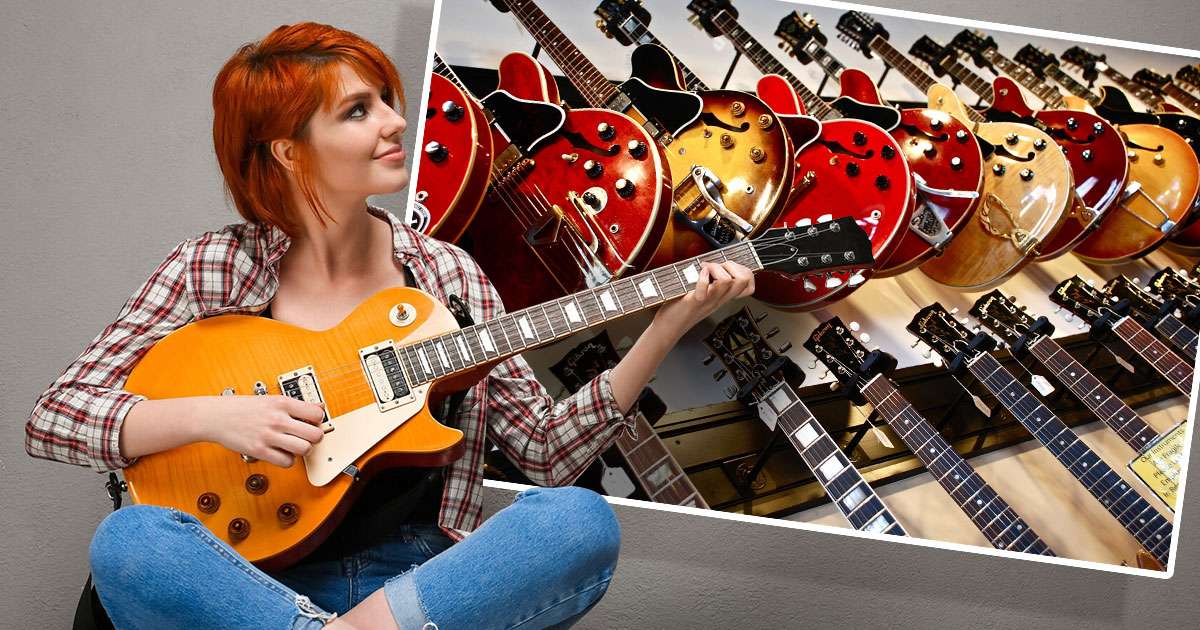Choose the Right Guitar: Tips for Picking the Best One

Who hasn’t dreamed of playing guitar in front of thousands of screaming fans? We might not be able to help you play any better, but we can put the right axe in your hands! This buying guide includes information that can help you choose an electric guitar for your needs. Since there’s so much to consider when purchasing an electric guitar, keep reading below.
Who You’re Buying For
When buying a guitar for a beginner, you want one that fits them well, sounds good, and matches their music style. Find out what guitar they admire and who their favorite guitarists are. Beginners need guitars that are easy to play and stay in tune, but looks and sound are important too. If they love a certain guitarist, aim for a guitar like theirs. Quality guitars often cost more, but they’re worth it for long-term satisfaction. If you’re getting a high-end guitar as a gift, it’s best to ask what they want to ensure they’re happy with it.
Budget
New guitar players will also need an amplifier and cable, along with these electric guitar accessories:
- Strap
- Tuner
- Extra picks
- Strings
- Case
- Stand
Under $300
In this price range, there are lots of options for beginners. Some stores offer value packages with everything you need: a guitar, amplifier, and accessories. These packages are designed to work together smoothly, making it easier to pick the right gear. Some even come with beginner lessons and other resources to keep you inspired. If you’re buying separately, consider investing more in the guitar than the amplifier. A good guitar can last longer, and you can upgrade the amp later if needed without changing your whole setup.
$300-$600
As you spend more, you have more choices. Still, it’s smart to put more money into the guitar than the amplifier, like we talked about earlier. With more options, you can find something that fits the player well. Many guitars in this range are upgrades of cheaper ones, with better features like hardware, electronics, wood, looks, and how they’re made. We’ll talk more about these upgrades later on.
$1000 and Up
In this range, there are lots of top-quality options. These guitars often have the best features and are upgrades from cheaper models, often seen as standard models. You don’t have to spend $1000 to get a great guitar, but most in this range will impress even the pickiest player.
Body Types of Electric Guitars
There are three main types of electric guitar shapes, each with its own traits: solid body, hollow body, and semi-hollow body.
Solid Body
Solid-body electric guitars are the most popular type and are crafted from a solid piece of wood. They come in various styles, from basic ones with one pickup to fancy ones with multiple pickups and electronic features. While they don’t resonate as much as hollow-body guitars, the type of wood still affects their sound.
Hollow Body
These electric guitars are called hollow-body guitars because their bodies are hollow inside, like acoustic guitars. Because of this, they make more sound, like an echo, because of how they’re made. They often have a curved top and can sometimes make a loud noise called feedback. Jazz guitarists often like hollow-body guitars because they have a warm, full sound and deep bass notes.
Semi-Hollow Body
Semi-hollow guitars are a bit like hollow-body guitars but with some differences. They still make a lot of sound, but they have a solid block in the middle that makes them more stable and reduces loud feedback noises. Blues players often enjoy the warm sound of semi-hollow guitars, and the solid block helps them sound strong and last longer. These guitars are good for lots of different music styles, like blues, jazz, and even punk rock.
Pickups and Electronics
Besides how the guitar looks, the parts inside, like the pickups and electronics, really change how it sounds.
Single-coil pickups are common in guitars. They’re made with a magnet and wire that catch string vibrations and turn them into electric signals, usually making bright sounds. Sometimes they hum or get affected by magnets. Famous musicians like Eric Clapton and John Mayer use them for their unique sound. Humbucker pickups were invented to fix the humming problem of single-coil pickups by using two single-coils wound together.
They make louder sounds and are great for rock and jazz music, used by famous guitarists like Slash and Jimmy Page. Piezo pickups, though less known, are like crystals and sit in the guitar’s saddle, using vibrations to make electric sounds, often imitating acoustic guitars. They can also make keyboard sounds and are often paired with magnetic pickups for more versatility.
Active Pickups and Electronics
Some guitars have active pickups that need batteries to work and have a preamp for adjusting the sound. They might also have filters and equalizers for more control over the sound. Guitars with active electronics usually make louder, clearer sounds than those with regular pickups, which are called passive.
Pickup Switching and Other Controls
Electric guitars usually come with several pickups, like single-coils or humbuckers, or a mix of both. These pickups, abbreviated as “S” for single-coils and “H” for humbuckers, can be found in different spots on the guitar, from the neck to the bridge. For instance, “SSH” means there’s a single-coil at the neck and middle positions and a humbucker at the bridge.
The location of these pickups affects the guitar’s sound: ones near the bridge produce a sharp, treble sound, while those closer to the neck give a warmer, bass-heavy tone. Guitars with multiple pickups allow you to choose between them using knobs or switches.
Apart from pickup selection, most guitars have volume and tone controls. Volume knobs adjust the guitar’s loudness, while tone knobs alter the sound’s characteristics from soft and warm to bright and sharp. Some guitars even feature extra switches for special effects or radical sound changes.
Modern guitars may include digital features, enabling you to switch between different sounds, like acoustic or violin tones, without needing to switch guitars. They may also offer the option to experiment with different tunings without changing the strings.
Scale Length
Scale length is how long the vibrating part of the string is, measured from the nut to the bridge. A longer scale length means tighter string tension, giving a bright sound with clear bass notes. A shorter scale length means less tension, making it easier to bend strings and play for smaller hands, with a warmer tone. Fender guitars usually have a 25.5 inch scale, while Gibson guitars have a 24.75 inch scale. PRS guitars are in between at 25 inches, aiming for a mix of warm tones and easy playability.
Neck Construction
The guitar neck, connected to the body, holds the fretboard and headstock, where tuners are attached. It has a metal truss rod to keep it straight and can be adjusted to keep the guitar’s pitch consistent. Fretboards are usually made of rosewood or ebony, though some with maple necks have matching fretboards. Most have dots or markers for position, sometimes on the side for easy visibility. The neck’s shape and width affect how easy it is to play and how comfortable it feels. There are mainly “C” or “U” shaped necks, but finding the right width and depth for your hand size is important. There are three main types of neck construction:
Bolt-on necks are attached to the guitar body with bolts, which is cheaper. They’re easy to replace if needed, for fixes or changes. But they don’t have as much sustain or resonance as guitars with set necks or neck-through construction.
Set necks are glued into the guitar body, making a sturdy connection that improves sustain and resonance. But fixing them if they break is harder.
Neck-through guitars have a neck that goes through the whole body, often with extra pieces attached on the sides. This makes the neck super strong and gives the guitar lots of sustain and resonance. Fixing the neck is tough and pricey, but because it’s so stable, it’s less likely to break.
Tonewoods
Ever wondered why the type of wood used in a guitar matters? Well, it does! The wood affects how long the strings vibrate and the overall tone of the guitar. Here are some common woods used:
- Mahogany: Makes guitars mellower due to their resonance. It’s commonly used for necks and backs.
- Maple: Known for its hardness and brightness, it is often used for necks and tops.
- Rosewood: Dense and beautiful, used for fretboards primarily.
- Ebony: Hard and silky, used for high-end fretboards.
- Ash: Offers bright tones and ringing sustain, often seen in solid body guitars.
- Alder: Similar to ash but less costly, common in electric guitars.
- Agathis: Resembles alder, found in newer, budget-friendly guitars.
- Nato: Known for warmth, used in the necks of inexpensive electric guitars.
Buy the Right Electric Guitar for the Best Experience
If you’re thinking about buying an electric guitar, this guide has got you covered! From choosing the right guitar for beginners to understanding pickups and electronics, we break down everything you need to know. Learn about different body types, pickup options, scale length, neck construction, and the impact of tonewoods on sound. Are you ready to find your perfect match? Dive in and make an informed decision for your musical journey!

